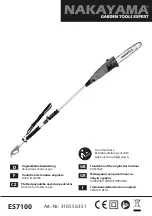
20
PHKSA 18-Li A1
GB
a)
Maintain a fi rm grip with both hands on the
saw and position your arms to resist kickback
forces. Position your body to either side of the
blade, but not in line with the blade.
Kickback
could cause the saw to jump backwards, but kick-
back forces can be controlled by the operator, if
proper precautions are taken.
b)
When blade is binding, or when interrupting
a cut for any reason, release the trigger and
hold the saw motionless in the material until
the blade comes to a complete stop. Never
attempt to remove the saw from the work or
pull the saw backwards while the blade is in
motion or kickback may occur.
Investigate and
take corrective actions to eliminate the cause of
blade binding.
c)
When restarting a saw in the workpiece, centre
the saw blade in the kerf and check that saw
teeth are not engaged into the material.
If saw
blade is binding, it may walk up or kickback from
the workpiece as the saw is restarted.
d)
Support large panels to minimise the risk of
blade pinching and kickback.
Large panels tend
to sag under their own weight. Supports must be
placed under the panel on both sides, near the
line of cut and near the edge of the panel.
e)
Do not use dull or damaged blades.
Unsharpened or improperly set blades produce
narrow kerf causing excessive friction, blade
binding and kickback.
f)
Blade depth and bevel adjusting locking levers
must be tight and secure before making cut.
If blade adjustment shifts while cutting, it may
cause binding and kickback.
g)
Use extra caution when sawing into existing
walls or other blind areas.
The protruding blade
may cut objects that can cause kickback.
Lower guard function
a)
Check lower guard for proper closing before
each use. Do not operate the saw if lower
guard does not move freely and close instantly.
Never clamp or tie the lower guard into the
open position.
If saw is accidentally dropped,
lower guard may be bent. Raise the lower guard
with the retracting handle and make sure it moves
freely and does not touch the blade or any
other part, in all angles and depths of cut.
b)
Check the operation of the lower guard spring.
If the guard and the spring are not operating
properly, they must be serviced before use.
Lower
guard may operate sluggishly due to damaged
parts, gummy deposits, or a build-up of debris.
c)
Lower guard may be retracted manually only
for special cuts such as "plunge cuts" and
"compound cuts".
Raise lower guard by retracting
handle and as soon as blade enters the material,
the lower guard must be released. For all other saw-
ing, the lower guard should operate automatically.
d)
Always observe that the lower guard is cover-
ing the blade before placing saw down on
bench or fl oor.
An unprotected, coasting blade
will cause the saw to walk backwards, cutting
whatever is in its path. Be aware of the time it
takes for the blade to stop after switch is released.
Safety guidelines for battery chargers
■
This appliance may be used by children aged
8 years and above and by persons with limited
physical, sensory or mental capabilities or lack of
experience and knowledge, provided that they are
under supervision or have been told how to use the
appliance safely and are aware of the potential risks.
Children must not use the appliance as a plaything.
Cleaning and user maintenance tasks may not be
carried out by children unless they are supervised.
This charger is suitable for indoor use only.
WARNING!
■
Do not operate the appliance with a dam-
aged cable, supply cord or mains plug. A
damaged power cord causes danger to life
by electric shock.
Supplementary notes
■
Do not use any grinding discs.
■
Use only saw blades with diameters corre-
sponding to the label on the saw.
■
When sawing wood or other materials which may
create dusts that are hazardous to health, always
connect a suitable, certifi ed vacuum extractor device.
■
Wear a dust mask when sawing wood.
■
Use only the recommended saw blades.
■
Always wear ear protectors.
IB_102867_PHKSA18-LiA1_LB1.indb 20
09.10.14 11:15
Summary of Contents for PHKSA 18-LI A1
Page 3: ...A B C...
Page 17: ...14 PHKSA 18 Li A1...








































